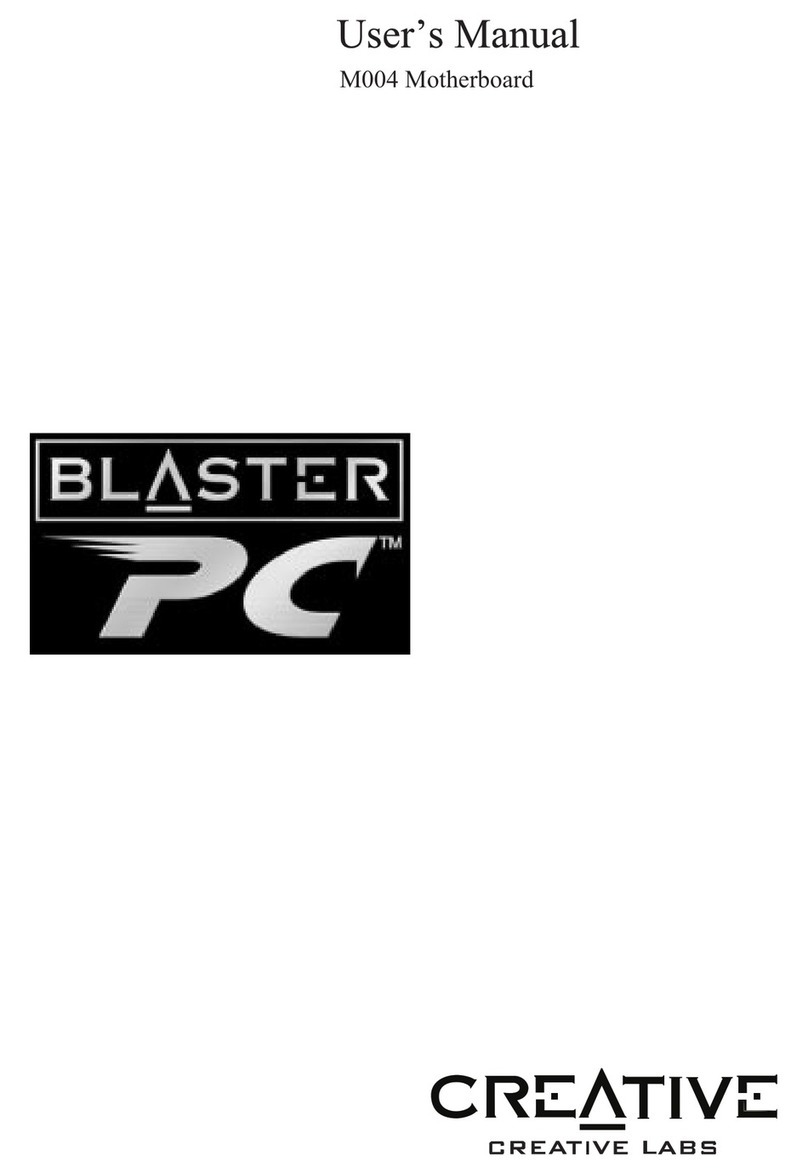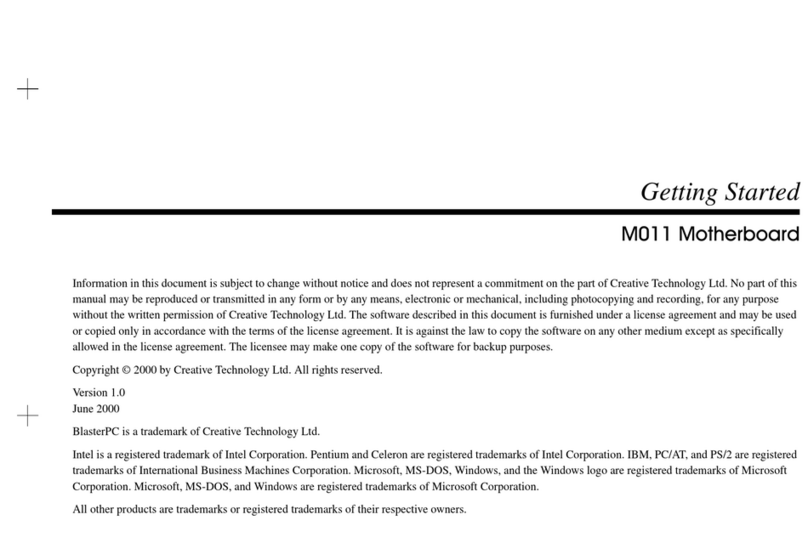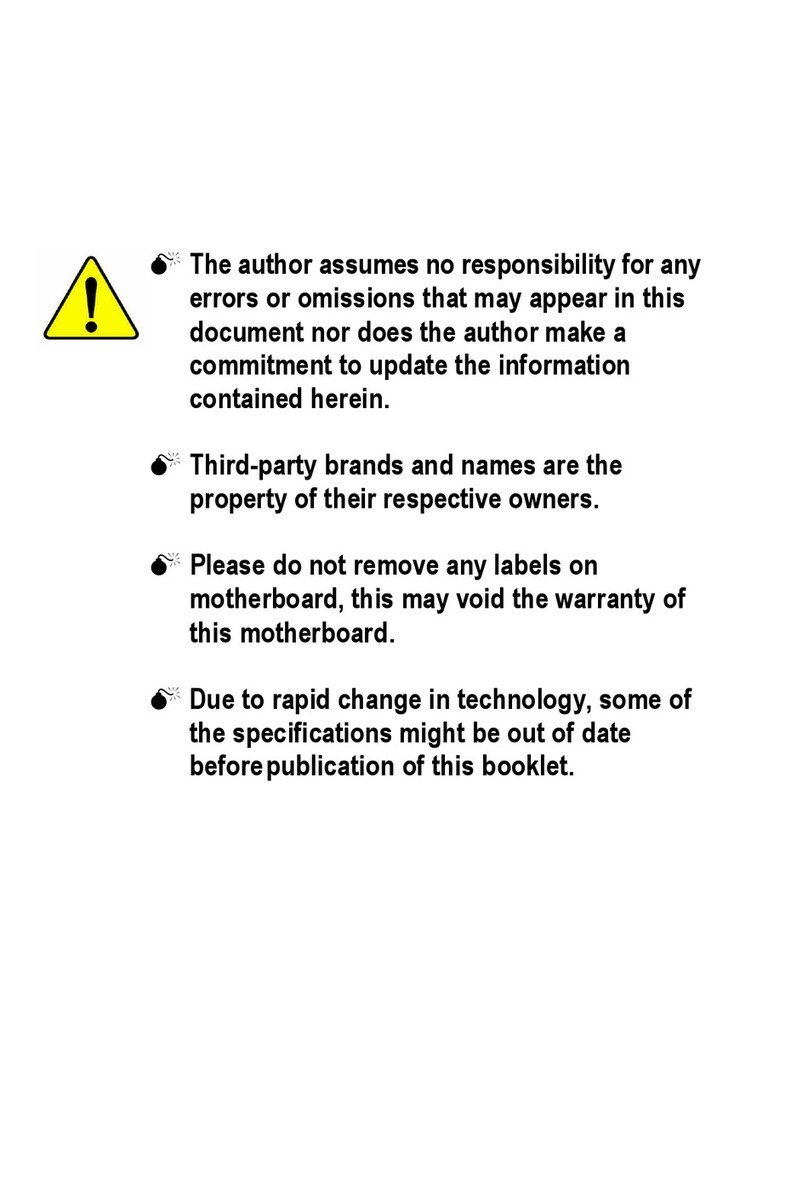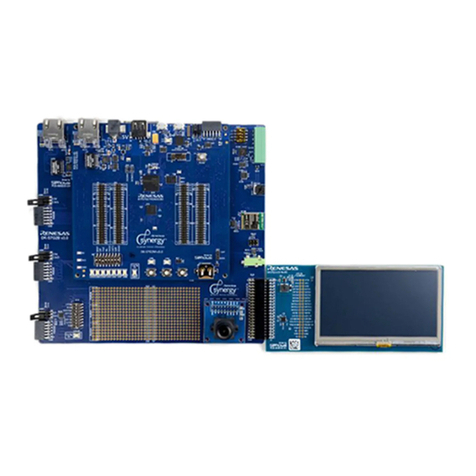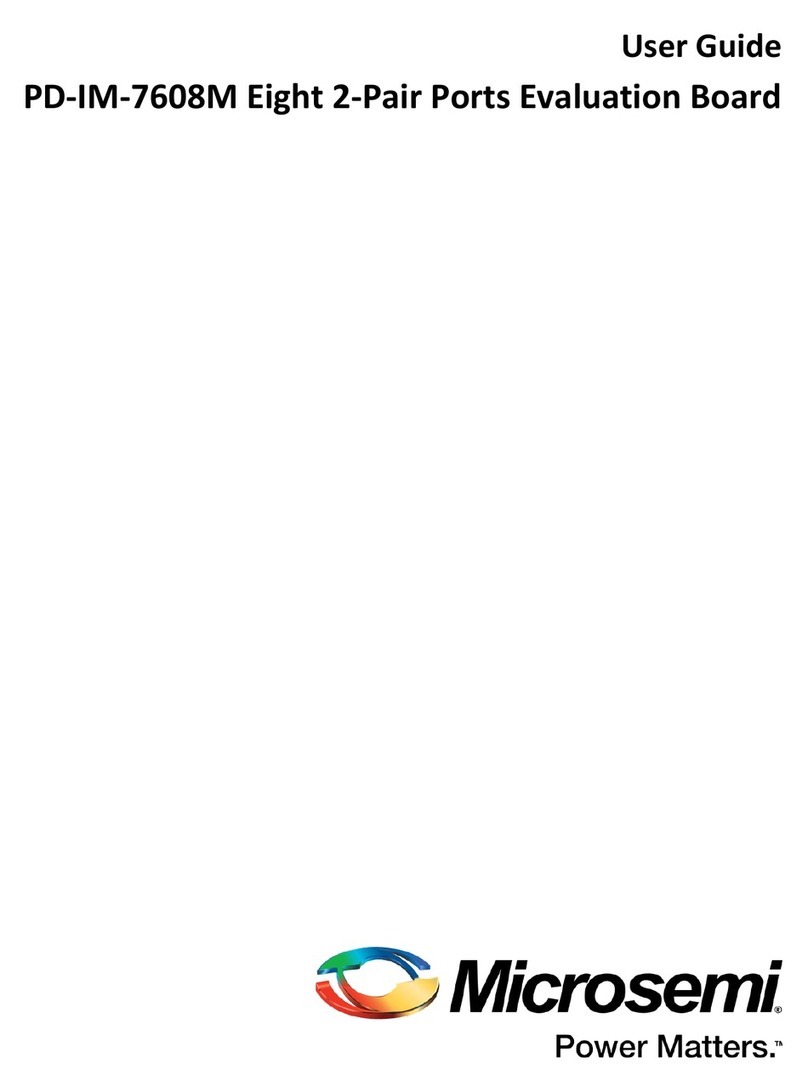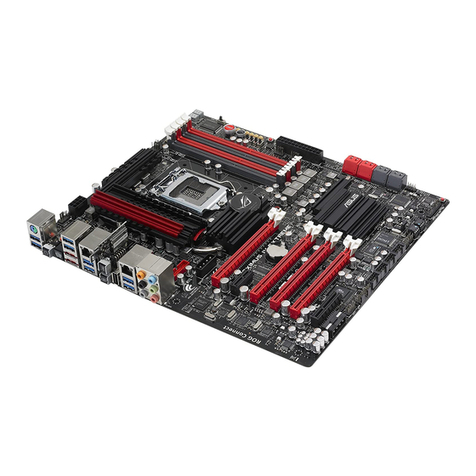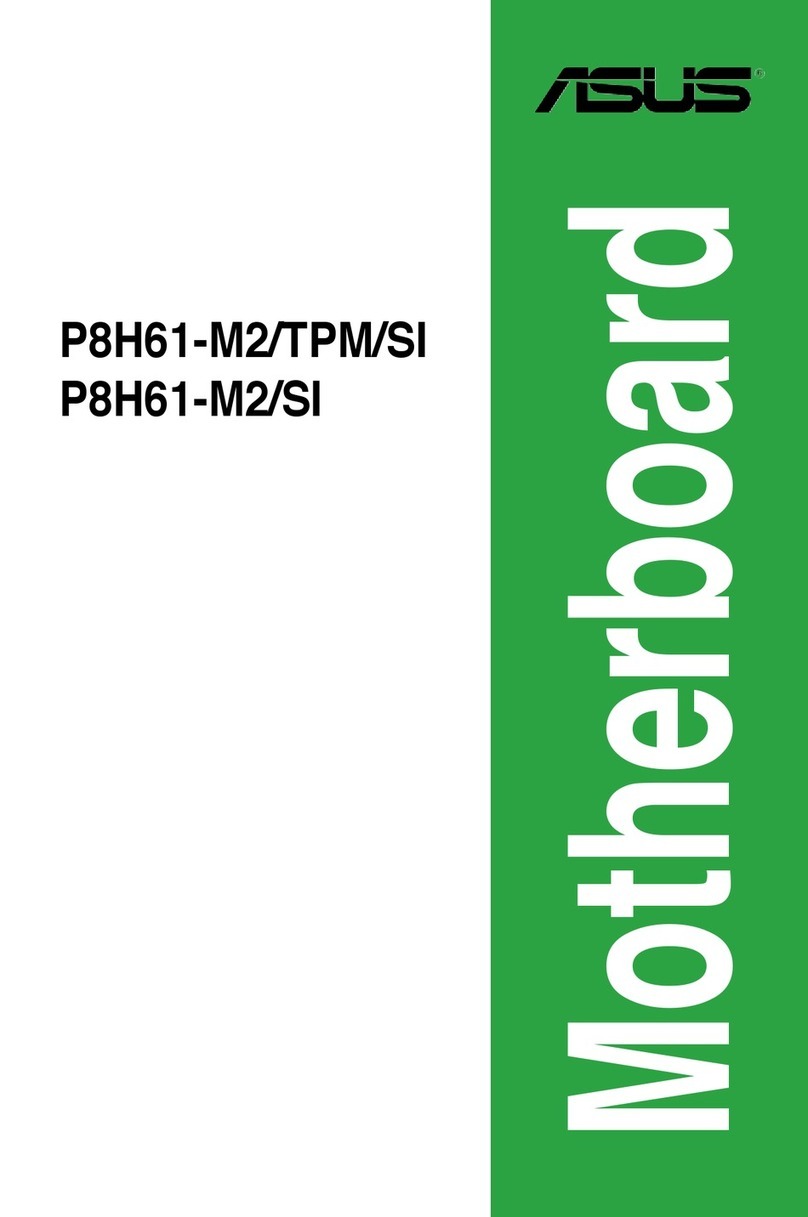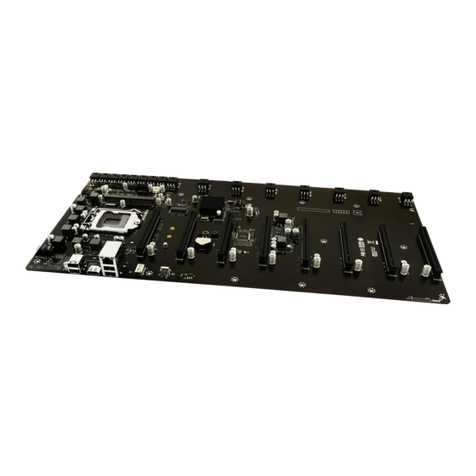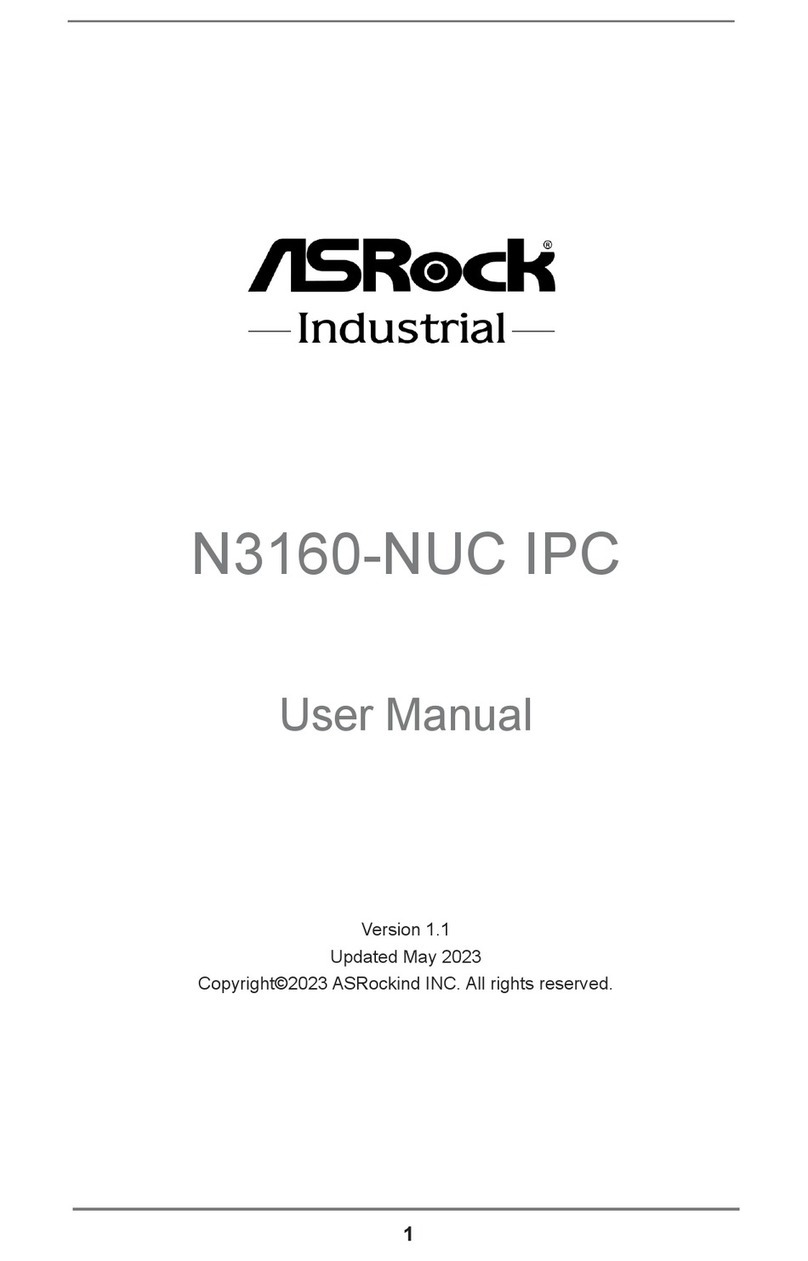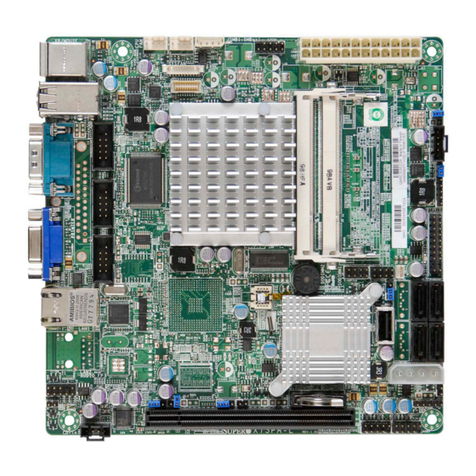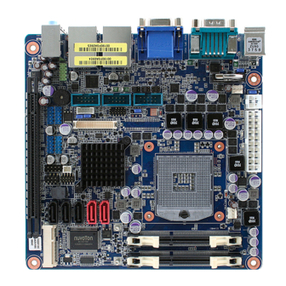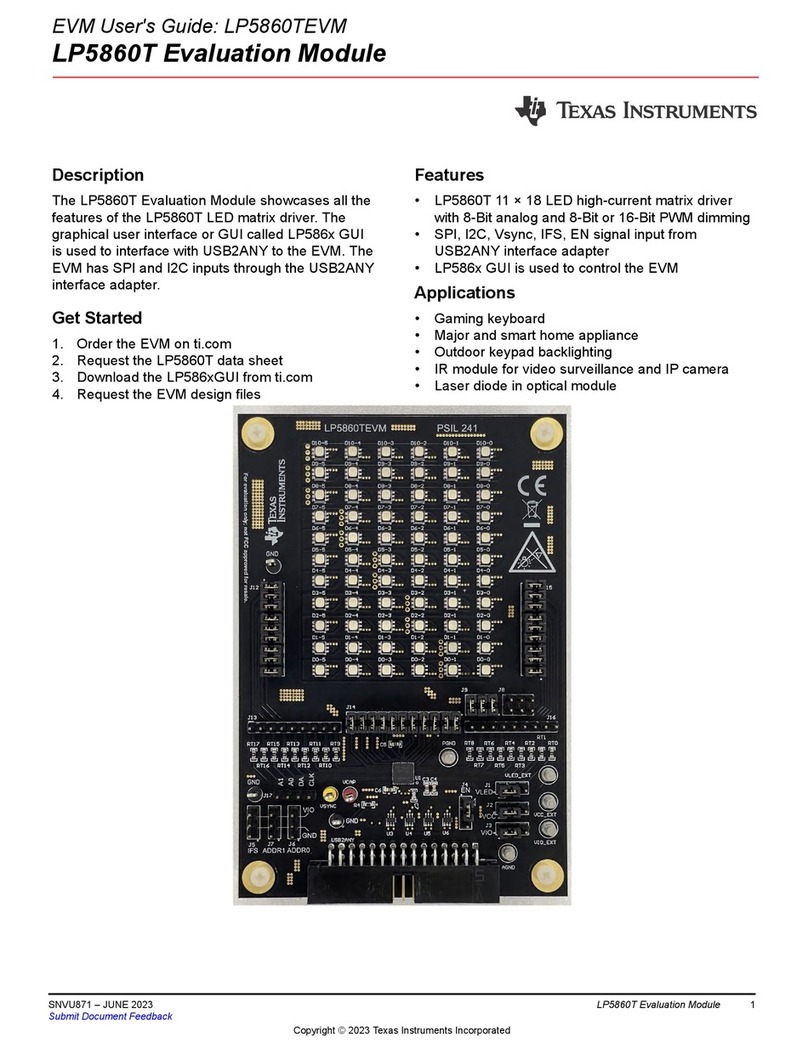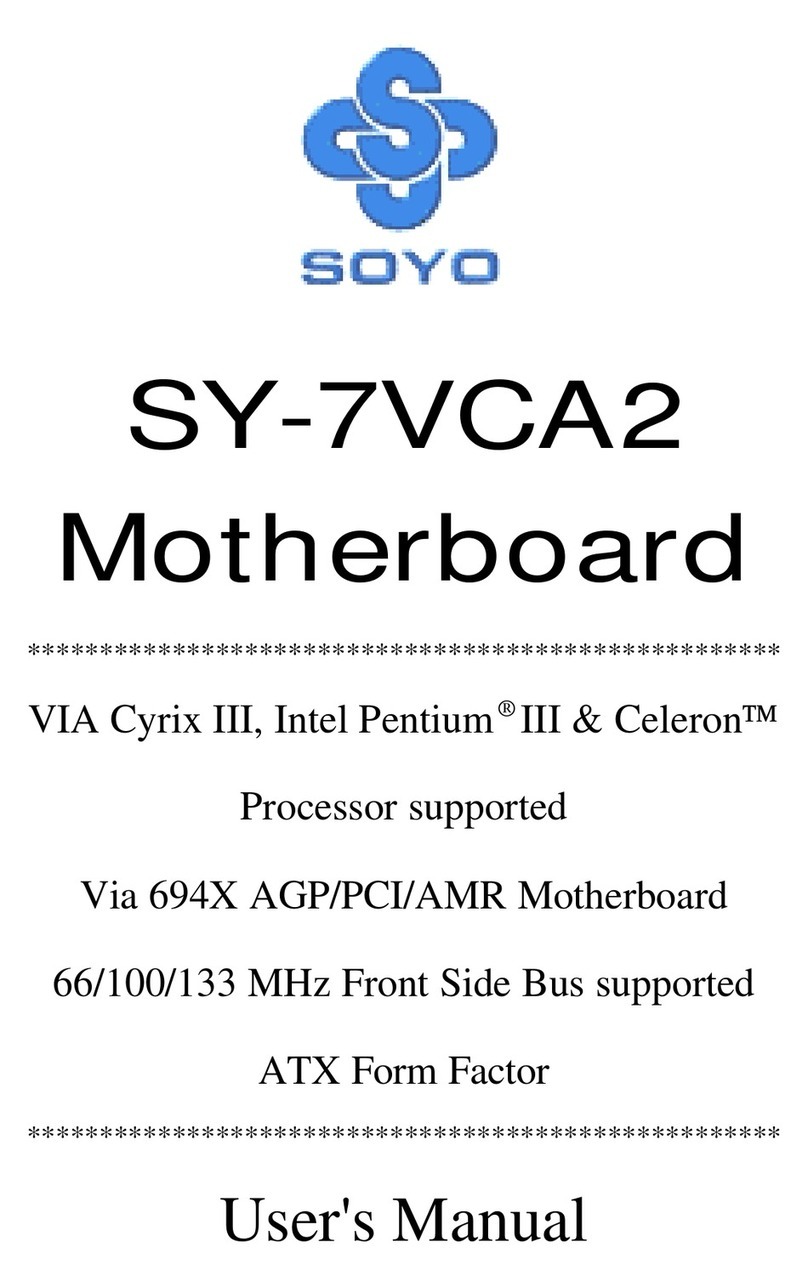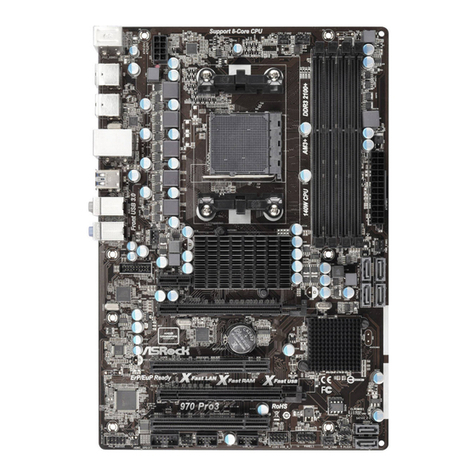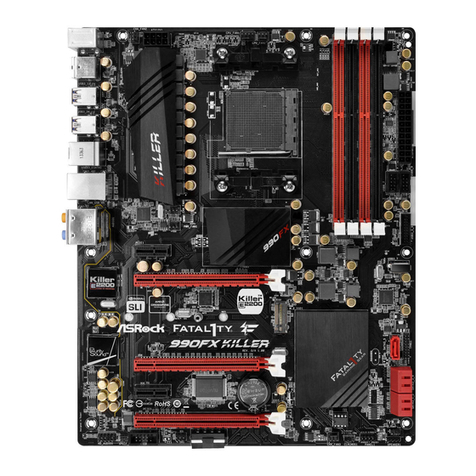Creative BLASTER PC M000 User manual

User’s Manual
M000 Motherboard

Getting Started
00RWKHUERDUG
Information in this document is subject to change without notice and does not represent a commitment on the part of Creative Technology Ltd. No part of this
manual may be reproduced or transmitted in any form or by any means, electronic or mechanical, including photocopying and recording, for any purpose
without the written permission of Creative Technology Ltd. The software described in this document is furnished under a license agreement and may be used
or copied only in accordance with the terms of the license agreement. It is against the law to copy the software on any other medium except as specifically
allowed in the license agreement. The licensee may make one copy of the software for backup purposes.
Copyright © 1998 by Creative Technology Ltd. All rights reserved.
Version 2.0
November 1998
Sound Blaster is a registered trademark of Creative Technology Ltd. Blaster, PC-DVD, Graphics Blaster Exxtreme, and BlasterPC are trademarks of Creative
Technology Ltd. PC SoundWorks is a trademark of Cambridge SoundWorks.
Intel is a registered trademark of Intel Corporation. Pentium™ II Processor is a registered trademark of Intel Corporation. IBM, PC/AT, and PS/2 are registered
trademarks of International Business Machines Corporation. Microsoft, MS-DOS, Windows, and the Windows logo are registered trademarks of Microsoft
Corporation. Microsoft, MS-DOS, and Windows are registered trademarks of Microsoft Corporation. All other products are trademarks or registered
trademarks of their respective owners.

6DIHW\,QIRUPDWLRQ
CAUTION: This device is intended to be installed by the user in a
CSA/TUV/UL certified/listed IBM AT or compatible personal
computers in the manufacturer’s defined operator access area. Check
the equipment operating/installation manual and/or with the
equipment manufacturer to verify/confirm if your equipment is
suitable for user-installed application cards.
ATTENTION: Ce carte est destiné à être installé par l’utilisateur,
dans un ordinateur compatible certifié CSA/TUV/UL ou listé IBM
AT, à l’intérieur de la zone définie par le fabricant. Consulter le
mode d’emploi ou le fabricant de l’appareil pour vérifier ou
confirmer si l’utilisateur peut y installer lui-même des cartes
périphériques.
1RWLFHIRUWKH86$
FCC Part 15: This equipment has been tested and found to comply
with the limits for a Class B digital device, pursuantto Part 15 of the
FCC Rules. These limits are designed to provide reasonable
protection against harmful interference in a residential installation.
This equipment generates, uses, and can radiate radio frequency
energy and, if not installed and used in accordance with the
instructions, may cause harmful interference to radio
communications. However, this notice is not a guarantee that
interference will not occur in a particular installation. If this
equipment does cause harmful interference to radio or television
reception, which can be determined by turning the equipment off and
on, the user is encouraged to try one or more of the following
measures:
❑Reorient or relocate the receiving antenna.
❑Increase the distance between the equipment and receiver.
❑Connect the equipment to an outlet on a circuit different from
that to which the receiver is connected.
❑Consult the dealer or an experienced radio/TV technician.
CAUTION: To comply with the limits for the Class B digital device,
pursuant to Part 15 of the FCC Rules, this device must be installed in
computer equipment certified to comply with the Class B limits.
All cables used to connect the computer and peripherals must be
shielded and grounded. Operation with non-certified computers or
non-shielded cables may result in interference to radio or television
reception.
0RGLILFDWLRQV
Any changes or modifications not expressly approved by the grantee
of this device could void the user’s authority to operate the device.
1RWLFHIRU&DQDGD
This apparatus complies with the Class “B” limits for radio
interference as specified in the Canadian Department of
Communications Radio Interference Regulations.
Cet appareil est conforme aux normes de CLASSE “B”
d’interference radio tel que spe’cifie’ par le Ministère Canadien des
Communications dans les règlements d’interfe’rence radio.
&RPSOLDQFH
This product conforms to the following Council Directive:
❑Directive 89/336/EEC, 92/31/EEC (EMC)
'HFODUDWLRQRI&RQIRUPLW\
According to the FCC96 208 and ET95-19
Importer’s Name: Creative Labs Inc.
Importer’s Address: 1901 McCarthy Boulevard
Milpitas, CA. 95035
United States
Tel: (408) 428-6600
Manufacturer’s Name: Creative Technology Ltd.
Manufacturer’s Address: 31 International Business Park
Creative Resource
Singapore 609921
declares under its sole responsibility that the product
Trade Name: Creative Labs
Model Number: M000
has been tested according to the FCC / CISPR22/85
requirementforClassBdevices andfound compliant with
the following standards:
EMI/EMC: ANSI C63.4 1992, FCC Part 15 Subpart B
This device complies with part 15 of the FCC Rules.
Operation is subject to the following two conditions:
1. This device may not cause harmful interference, and
2. This device must accept any interference received,
including interference that may cause undesirable
operation.
Ce matériel est conforme à la section 15 des régles FCC.
Son Fonctionnement est soumis aux deux conditions
suivantes:
1. Le matériel ne peut étre source D’interférences et
2. Doit accepter toutes les interférences reques, Y compris
celles pouvant provoquer un fonctionnement indésirable.
Compliance Manager
Creative Labs, Inc.
November 5, 1998

iii
&RQWHQWV
,QWURGXFWLRQ
Document Conventions............................................................................................ viii
7KH00RWKHUERDUG
Features..................................................................................................................................1-1
Specifications ........................................................................................................................1-2
Intel Chipset..................................................................................................1-2
CPU Support.................................................................................................1-2
Versatile Memory Supports.........................................................................1-2
PCI and ISA Expansion Slots...................................................................... 1-2
AGP Slot.......................................................................................................1-2
Onboard GiGA-I/O......................................................................................1-3
Onboard PCI Bus Master IDE Controller...................................................1-3
Onboard 20-pin ATX Power Supply........................................................... 1-3
System BIOS................................................................................................1-3
ACPI..............................................................................................................1-3
Board Size.....................................................................................................1-3
Advanced Features....................................................................................................1-4
CPU Plug and Play.......................................................................................1-4
Low EMI....................................................................................................... 1-4

iv
Dual Function Power Button........................................................................1-4
Wake-On-LAN..............................................................................................1-4
Modem Ring Power-on................................................................................1-4
PS/2 Keyboard & Mouse Power-on.............................................................1-4
More Advanced Features (optional).........................................................................1-5
Voltage Monitoring.......................................................................................1-5
FAN Status Monitoring ................................................................................1-5
7KH3HQWLXP,,3URFHVVRU
About the Pentium II Processor............................................................................................2-1
Installing the Hardware for the Pentium II Processor..........................................................2-2
Components of the Pentium II Processor’s Retention Mechanism........................2-3
Step 1: To install the Retention Mechanism ............................................................2-4
Components of the Pentium II Processor’s Heat Sink Support..............................2-5
Step 2: To install the Heat Sink Support ..................................................................2-6
Step 3: To mount the Pentium II Processor..............................................................2-8
7KH&HOHURQ3URFHVVRU
About the Celeron Processor.................................................................................................3-1
Installing the Hardware for the Celeron Processor..............................................................3-2
Components of the Celeron Processor’s Retention Mechanism.............................3-3
Step 1: To assemble the Retention Mechanism.......................................................3-4
Components of the Celeron Processor’s Heat Sink.................................................3-4
Step 2: To mount the heat sink onto the Celeron processor....................................3-5
Step 3: To mount the Celeron Processor..................................................................3-8
&RQQHFWRUV
Front Panel Connectors.........................................................................................................4-1
Back Panel Connectors..........................................................................................................4-3
Other Connectors...................................................................................................................4-4

v
-XPSHU6HWWLQJV
About Jumpers ...................................................................................................................... 5-1
Changing Jumper Settings....................................................................................................5-2
To configure the CPU Bus Clock Multiplier...........................................................5-3
To configure the PCI Bus Clock.............................................................................. 5-5
To clear the CMOS................................................................................................... 5-6
To flash the EEPROM Vpp...................................................................................... 5-7
To enable or disable the Keyboard & PS/2 Mouse Power-On function................5-8
0HPRU\&RQILJXUDWLRQDQG%,266HWWLQJV
Memory Configuration.........................................................................................................6-1
BIOS Settings........................................................................................................................6-2
To change BIOS settings in CMOS.........................................................................6-3
The CMOS Setup Utility Menu............................................................................... 6-4
Standard CMOS Setup.............................................................................................6-6
BIOS Features Setup................................................................................................6-9
Chipset Features Setup...........................................................................................6-13
Power Management Setup......................................................................................6-19
PnP/PCI Configuration Setup................................................................................6-23
Integrated Peripherals.............................................................................................6-26
Password Setting.....................................................................................................6-31


vii
,QWURGXFWLRQ
This manual provides you with information on how to set up and use your motherboard:
❑Chapter 1, “The M000 Motherboard”
Gives you a list of the motherboard’s capabilities and features. It also provides the
motherboard’s technical specifications and a diagram of the motherboard’s layout.
❑Chapter 2, “The Pentium® II Processor”
Gives you a brief introduction of the Intel®Pentium II processor and shows you how to
mount the processor on the motherboard.
❑Chapter 3, “The Celeron™ Processor”
Gives you a brief introduction of the Intel Celeron processor and shows you how to mount
the processor on the motherboard.
❑Chapter 4, “Connectors”
Provides information on the connectors on your motherboard.
❑Chapter 5, “Jumper Settings”
Provides information on the location and settings of the jumpers on your motherboard.
❑Chapter 6, “Memory Configuration and BIOS Settings”
Provides instructions on how to specify BIOS settings in the CMOS Setup utility. It also
provides a list of descriptions for the setup items.

viii
'RFXPHQW&RQYHQWLRQV The following typographical conventions are used throughout this document:
Table i: Document conventions
This Represents
bold Text that must be entered exactly as it appears.
italic Title of a book or a placeholder, which represents the information you
must provide.
UPPERCASE Directory name, file name, or acronym.
The notepad icon indicates information that is of particular importance
and should be considered before continuing.
The alarm clock designates a caution or warning that can help you avoid
situations involving risk.

The M000 Motherboard 1-1
1
7KH00RWKHUERDUG
This chapter is organized as follows:
❑Features
❑Specifications
)HDWXUHV M000 is a highly integrated IBM PC/AT compatible system board designed to meet the
industry’s most demanding desktop applications.
This motherboard is based on the Intel 82440LX AGPset chipset which features the Intel®
Pentium®II processor or the Intel Celeron™processor (depending on the configuration of the
computer you have purchased) with MMX technology. It provides 256 KB or 512 KB of level
2 high-performance pipelined burst cache, and four 168-pin Dual Inline Memory Module
(DIMM) sockets. These DIMM sockets can support up to a total of 512 MB of SDRAM or EDO
DRAM.
M000 also comes with an Accelerated Graphics Port (AGP) slot, a high-performance hardware
interface for graphics-intensive applications, such as 3D applications. The AGP slot is
independent of the Peripheral Component Interconnect (PCI) bus and is designed to be used
exclusively with graphic display devices. The M000 supports 3.3 V AGP devices with data
transfer rates up to 133 MHz, and it allows a data throughput rate of 500 MB/sec.
M000 is built with four PCI bus slots, thus providing a high bandwidth data path for intensive
data movement functions. In addition, M000 has three ISA slots.

1-2 The M000 Motherboard
The Intel’s 82440LX AGPset chipset provides an integrated Bus Mastering IDE controller with
two high-performance IDE interfaces. You can connect up to four IDE devices to the controller
and achieve data transfer rates of up to 33 MB/sec.
The onboard Giga I/O controller provides standard PC I/O functions: floppy drive interface,
two First In First Out (FIFO) serial ports, an Infrared Data Association (IrDA) device port, and
a parallel port that supports Standard Parallel Port (SPP), Enhanced Parallel Port (EPP), and
Extended Capabilities Port (ECP).
6SHFLILFDWLRQV
,QWHO&KLSVHW ❑Features Intel’s 440LX AGPset with I/O subsystems.
&386XSSRUW ❑Intel Pentium II 233 MHz, 266 MHz, 300 MHZ, and 333 MHz
or Intel Celeron processor 266 MHz, 300 MHz and 333 MHz
or Intel Celeron processor 300 A and 333 A (with L2 cache).
9HUVDWLOH0HPRU\
6XSSRUWV
❑Four DIMM sockets that support 168-pin 3.3V SDRAM and EDO DRAM memory
modules, with maximum possible memory size of up to 512MB.
Configurable support for Error Checking and Correcting (ECC).
3&,DQG,6$([SDQVLRQ
6ORWV
❑Provides four 32-bit PCI slots and three 16-bit ISA slots.
$*36ORW ❑Supports AGP cards for high-performance, component-level connection targeted at 3D
graphical display applications.

The M000 Motherboard 1-3
2QERDUG*L*$,2 ❑Provides one floppy drive port, one optional PS/2 mouse connector, two high-speed UART
compatible serial ports and one parallel port with ECP and EPP capabilities. Serial Port 2
can also be directed from COM2 to the infrared module for wireless connections.
2QERDUG3&,%XV0DVWHU
,'(&RQWUROOHU
❑Two Ultra DMA/33 Bus Master IDE ports that support four IDE devices and provide data
transfer rates of up to 33 MB/sec. This controller supports Enhanced PIO Modes 3 and 4,
and Bus Master IDE DMA Mode 2 devices.
2QERDUGSLQ$7;
3RZHU6XSSO\
❑Provides ATX power connector onboard supports soft-on/off function.
6\VWHP%,26 ❑Provides licensed Award V4.51PG BIOS on Flash Electrically Erasable Programmable
Read-Only Memory (EEPROM). Supports Green PC, DMI and bundled with NCR SCSI
BIOS.
$&3, ❑Support ACPI (Advanced Configuration and Power Interface) function. ACPI provides
more energy-saving features for future operating systems that support OS Direct Power
Management (OSPM) functionality.
%RDUG6L]H ❑ATX form factor 305mm x 170mm.

1-4 The M000 Motherboard
$GYDQFHG)HDWXUHV
&383OXJDQG3OD\ ❑CPU Plug and Play function. This means that there is no need to adjust the onboard system
clock and CPU multiplier. When the system is switched on for the first time, BIOS will set
the CPU clock speed to 233 MHz automatically. If your CPU speed is higher than 233 MHz,
just adjust the CPU speed in the CMOS setup.
/RZ(0, ❑Built-in Spread Spectrum. ±1.5% modulation and automatic clock shut-off of unused PCI/
SDRAMS slots to reduce the EMI.
'XDO)XQFWLRQ3RZHU
%XWWRQ
❑The system can be in one of two modes, Suspend or Soft-off.
If you hold the Power button down for less than 4 seconds, the system will go into the
Suspend mode. If you hold the Power button for more than 4 seconds, the system will go
into the Soft-off mode.
:DNH2Q/$1 Automatic switching on of the system when LAN is activated.
(This function supports Intel LAN cards only.)
0RGHP5LQJ3RZHURQ ❑Automatic switching on of the system when the modem ring is activated.
36.H\ERDUG0RXVH
3RZHURQ
❑Automatic switching on of the system by stroking the keyboard or double-clicking the PS/2
mouse.

The M000 Motherboard 1-5
0RUH$GYDQFHG
)HDWXUHVRSWLRQDO
9ROWDJH0RQLWRULQJ ❑System voltage levels are monitored to ensure stable current to the motherboard
components. Voltages include VCORE and VL2 for the CPU, and +5V, +12V, -5V, -12V for
the system.
)$16WDWXV0RQLWRULQJ ❑CPU fans are monitored for RPM and failure to prevent overheating of the CPU.
(A CPU cooling fan with RPM sensor is required.)

1-6 The M000 Motherboard
Figure 1-1 on page 1-6 is a diagram of the M000 motherboard for your reference.
Figure 1-1: The M000 motherboard
ATX Power Connector
System Clock (JP39)
EISCA Cooler
Connector
Two E-IDE Connectors
Floppy Connector
CPU Multiplier (JP37)
Clear CMOS (JP19)
Three ISA Slots
Programmable
Flash EEPROM
Flash EEPROM Vpp (J17)
AGP FAN Connector
AGP Slot
Serial Port
Connector (COM1)
Parallel Connector
Serial Port
Connector (COM2)
Slot 1
PS/2 Keyboard/
Mouse Connectors
USB Connectors
K/B & PS/2 Mouse
Power -On setting (JP38)
IR Connector
Four DIMM Sockets
Jumper (J44)
Giga-I/O Chip
CPU FAN Connectors
440LX AGPSet
440LX AGPSet
Four PCI Slots

The Pentium® II Processor 2-1
2
7KH3HQWLXP,,3URFHVVRU
This chapter consists of the following sections:
❑About the Pentium II Processor
❑Installing the Hardware for the Pentium II Processor
$ERXWWKH
3HQWLXP,,
3URFHVVRU
The Pentium II processor and the Celeron™processor are the latest additions to the P6 processor
family. They combine the architectural advances in the Pentium Pro processor with the
instruction set extensions of MMX technology. They are fully compatible with the huge base
of Intel architecture-based PC software.
Inaddition, the Pentium II processor deliversnewlevelsof performance foradvanced media and
communications software including powerful, realistic graphics and imaging capabilities, video
conferencing, and the ability to run full-screen, full-motion video. The combination of these
advanced features makes the Pentium II processor the ideal choice for executing modern 32-bit
CPU-intensive and multimedia-enhanced application work loads using advanced 32-bit
operating systems.
The Pentium II processor has a separate 32 KB, on-chip, non-blocking Level 1 cache which runs
at the same speed as the processor. It also has a 512 KB or 256 KB onboard Level 2 non-
blocking cache which runs at half the speed of the processor.

2-2 The Pentium® II Processor
,QVWDOOLQJWKH
+DUGZDUHIRUWKH
3HQWLXP,,3URFHVVRU
The Pentium II processor uses Single Edge Contact (SEC) cartridge packaging technology
which enables high volume availability and improved handling protection.
Figure 2-1 shows the front, rear, and top views of the Pentium II processor (without heat sink
mounted).
The Pentium II processor requires the Retention Mechanism (RM) and the Heat Sink Support
(HSS) to hold the base processor in the SEC cartridge.
Rear View
Top View
Front View
Figure 2-1: Different views of the Pentium II processor.

The Pentium® II Processor 2-3
The following sections will show you how to install the RM and HSS. If you should need help
with the mechanism, please contact your dealer.
Before you proceed, do the following:
1. Switch off the computer.
2. Remove the motherboard from the chassis.
3. Place it on a workbench.
4. Remove all DIMM chips, cables, and cards from the motherboard so that it is bare.
&RPSRQHQWVRIWKH
3HQWLXP,,3URFHVVRU·V
5HWHQWLRQ0HFKDQLVP
The Retention Mechanism (RM) consists of the following parts:
❑Retention Mechanism (RM)
A plastic guide with captive nuts
that hold the SEC cartridge in the Slot 1 connector.
❑RM Attachment Pins
Plastic pins inserted through the RM to secure it to
the motherboard.
Four pins are required for each assembly.
Figure 2-2: The Retention Mechanism.
Figure 2-3: The RM attachment pins.

2-4 The Pentium® II Processor
6WHS7RLQVWDOOWKH
5HWHQWLRQ0HFKDQLVP
1. Locate the Retention Mechanism (RM) mounting holes and the “Pin 1” mark of Slot 1 on
the motherboard (see Figure 2-4).
2. Mount the RM onto Slot 1. Make sure that the square cut mark of the RM has the same
orientation as Pin 1 of Slot 1 (see Figure 2-5). Then, insert four RM attachment pins through
the RM to secure it to the motherboard.
Figure 2-4: Locating the mounting holes on the motherboard.
Figure 2-5: Mounting the RM onto Slot 1.
Four pins are required for each
assembly.

The Pentium® II Processor 2-5
&RPSRQHQWVRIWKH
3HQWLXP,,3URFHVVRU·V
+HDW6LQN6XSSRUW
The Heat Sink Support (HSS) consists of the following parts:
❑HSS Base
A plastic support bar mounted to the motherboard under
the ATX heat sink.
❑HSS Pins
Plastic pins inserted through the HSS base to secure it to the
motherboard.
Two pins are required for each assembly.
❑HSS Top Bar
A plastic bar that clips onto the HSS base through the fins
of the ATX heat sink.
Figure 2-6: The HSS base.
Figure 2-7: The HSS pins.
Figure 2-8: The HSS top bar.
Table of contents
Other Creative Motherboard manuals

